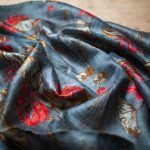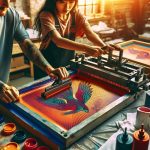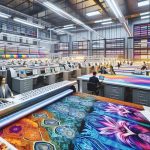Did you know that the global digital fabric printing market is expected to reach $2.7 billion by 2025? This growth highlights the increasing significance of digital fabric printing in various industries. You can achieve unparalleled color precision and intricate design control with the right techniques and equipment. Choosing between inkjet, sublimation, and direct-to-fabric printers can significantly influence your project's outcome. By mastering suitable fabrics and printing techniques, you'll reveal numerous advantages and applications in fashion, home decor, and more. Let's explore how you can leverage this technology to its full potential.
Table of Contents
Key Takeaways
- Color Accuracy and Detail: Digital fabric printing ensures unparalleled color accuracy and intricate pattern details.
- Printer Types: Different printers like inkjet, sublimation, and UV cater to various fabric types and printing needs.
- Suitable Fabrics: Best results on natural fibers; synthetic fabrics need pre-treatment for optimal ink absorption.
- Advantages for Designers: Offers customization, flexibility, and quick turnaround times, ideal for modern designers.
- Industry Applications: Widely used in fashion, home decor, sportswear, interior design, and personalized marketing strategies.
Understanding Digital Fabric Printing
Digital fabric printing is a modern technique that uses digital technology to print designs directly onto fabrics. This method offers unparalleled color accuracy, ensuring your designs come to life with the exact hues you envision. You have complete design control, allowing for intricate patterns and fine details that traditional methods might miss. The precision of digital fabric printing means you can replicate complex designs consistently, making it ideal for custom and high-end projects.
When it comes to cost effectiveness, digital fabric printing stands out. Traditional printing methods often require large minimum orders and substantial setup costs. In contrast, digital printing allows you to print smaller batches economically, reducing waste and saving money. This makes it perfect for both small businesses and large-scale operations looking to optimize their production costs.
Environmental impact is another significant advantage. Digital fabric printing uses less water and energy compared to conventional printing methods. By minimizing waste and utilizing eco-friendly inks, you can remarkably reduce your environmental footprint. This sustainable approach not only benefits the planet but can also enhance your brand's reputation among environmentally conscious consumers.
Mastering digital fabric printing means you're embracing a versatile, efficient, and eco-friendly technology that sets you apart in the fabric printing industry.
Types of Digital Printers
When it comes to digital fabric printing, you'll encounter different types of printers, each with its own strengths. Inkjet and sublimation printers offer distinct advantages depending on your fabric and design needs.
Additionally, direct-to-fabric printers provide another option for achieving high-quality prints.
Inkjet Vs. Sublimation
Choosing between inkjet and sublimation printers depends on your fabric type and desired print quality. Inkjet printers offer versatility in fabric choices, allowing you to print on both natural and synthetic materials. They provide high print quality, but the cost comparison shows they can be pricier due to the need for specialized inks and pretreatment processes.
On the other hand, sublimation printers excel with synthetic fabrics, especially polyester. They produce vibrant, durable prints that are less likely to fade or crack over time. Sublimation is generally more cost-effective for bulk printing, as it doesn't require pretreatment. However, it's limited to light-colored synthetic fabrics, which might restrict your design possibilities.
From an environmental impact perspective, inkjet printers often generate more waste due to the need for multiple layers of ink and pretreatment chemicals. Sublimation printing is cleaner, using heat to transfer dye directly into the fabric fibers, resulting in minimal waste.
Durability considerations also favor sublimation printing, as the dye becomes part of the fabric, ensuring long-lasting results.
Direct-to-Fabric Printers
As you explore the landscape of fabric printing, you'll find various types of direct-to-fabric printers that cater to different needs and materials. These printers are essential for achieving high-quality prints and maintaining efficient production workflows.
Here are four main types you should know about:
- Piezoelectric Inkjet Printers: These printers use piezoelectric crystals to eject ink droplets onto the fabric. They're known for their precise color management and high resolution. Proper printer maintenance is vital to keep the nozzles clean and maintain consistent quality control.
- Thermal Inkjet Printers: Utilizing heat to create ink droplets, thermal inkjet printers are excellent for quick and cost-effective printing. However, they require careful fabric handling to avoid damage and preserve print quality.
- Sublimation Printers: Ideal for polyester fabrics, sublimation printers use heat to transfer dye onto the fabric. You'll need to manage colors carefully to achieve vibrant prints. Regular quality control checks will help ensure that colors remain consistent across different batches.
- UV Printers: These printers use ultraviolet light to cure the ink, making them suitable for a variety of fabrics. They offer excellent durability but require attention to fabric handling to prevent UV exposure from degrading the material.
Understanding these printer types will help you optimize your printing process and achieve superior results.
Suitable Fabrics
Not all fabrics are ideal for digital fabric printing, so it's crucial to know which ones work best. When you're selecting fabrics, consider fabric compatibility as a top priority.
Natural fibers like cotton, silk, wool, and linen typically offer the best results due to their absorbent nature, which allows for excellent ink penetration. This compatibility guarantees that the colors you print will be vibrant and true to your design.
Synthetic fabrics such as polyester can also be used, but they often require a pre-treatment to enhance ink absorption and color vibrancy. Blends of natural and synthetic fibers can sometimes pose challenges, but with the right pre-treatment, they can still yield impressive prints.
If you're aiming for the highest color vibrancy, prioritize fabrics that have a tight weave and smooth surface. These characteristics help the fabric hold the ink better and produce sharper, more detailed images.
Avoid fabrics with heavy textures or loose weaves, as they can cause the ink to bleed and result in a less defined print. By carefully selecting the appropriate fabrics, you'll achieve professional and stunning results in your digital fabric printing projects.
Printing Techniques
Mastering different printing techniques is vital for achieving the best results in digital fabric printing. You'll need to understand the nuances of each method to elevate your work.
Here's a breakdown to help you get started:
- Direct-to-Fabric Printing: This technique involves printing directly onto the fabric. It's important to focus on color calibration and print quality to guarantee vibrant, long-lasting results. Always check your printer settings and use high-quality inks tailored for your fabric type.
- Sublimation Printing: Ideal for polyester fabrics, this method turns solid dye into gas without passing through a liquid state, embedding the color into the fabric. Proper fabric preparation is key to avoid ghosting or fading. Pre-treat your fabric and make sure it's free from dust and wrinkles.
- Heat Transfer Printing: This involves printing your design on special transfer paper, then using heat and pressure to transfer the ink onto the fabric. Maintenance tips include regularly cleaning your heat press and replacing worn-out transfer papers to maintain print quality.
- Reactive Printing: Best for natural fibers like cotton and silk, this technique uses reactive dyes that form a chemical bond with the fabric. Guarantee thorough washing and fixing of the fabric post-printing to enhance color fastness and durability.
Master these techniques, and you'll transform your digital fabric printing projects.
Advantages for Designers
With digital fabric printing, you can easily customize designs and enjoy greater flexibility in your creative process.
You'll also benefit from the speed and efficiency this technology offers, allowing you to bring your visions to life faster.
These advantages make digital fabric printing an ideal choice for contemporary designers.
Customization and Flexibility
Digital fabric printing offers unparalleled customization and flexibility, allowing designers to bring their most intricate visions to life. You can create personalized designs that stand out, giving you artistic freedom like never before. This technology lets you experiment with colors, textures, and patterns without the constraints of traditional methods.
Here are four ways digital fabric printing enhances customization and flexibility:
- Unlimited Color Palette: You're no longer restricted to a limited set of colors. Digital printing allows you to choose from millions of colors, ensuring your designs are vibrant and accurate.
- Detailed Patterns: Whether you're working with intricate floral prints or complex geometric designs, digital printing captures every tiny detail with precision, enabling you to produce high-quality, detailed patterns.
- Customization at Scale: You can easily modify designs to meet individual client needs or market trends. This flexibility allows you to offer truly personalized products, setting you apart from competitors.
- Eco-Friendly Options: Many digital printing processes use less water and produce less waste than traditional methods, aligning with sustainable practices and appealing to environmentally-conscious consumers.
Speed and Efficiency
In addition to unmatched customization, digital fabric printing also enhances speed and efficiency, making it a designer's best ally. You can reduce turnaround times significantly, guaranteeing your designs reach the market faster. This is essential for staying ahead in the competitive fashion industry.
Production optimization is at the core of digital fabric printing, allowing you to streamline your workflow and manage multiple projects simultaneously without compromising quality.
Technology integration plays a pivotal role in enhancing speed and efficiency. Advanced software solutions enable seamless design transfers from digital screens to fabric, eliminating the need for cumbersome manual processes. You can easily adjust designs, colors, and patterns, making real-time changes that are immediately reflected in your prints. This dynamic capability is a game-changer for rapid prototyping and quick iterations.
Equipment maintenance is another key factor. Digital printers require less frequent maintenance compared to traditional methods, reducing downtime and keeping your production line running smoothly. By following regular maintenance schedules, you can ensure your equipment operates at peak performance, further enhancing overall efficiency.
Embrace digital fabric printing to elevate your design process, achieve superior results, and maintain a competitive edge.
Industry Applications
You'll find digital fabric printing transforming various industries, from fashion to home decoration, with its innovative capabilities. In the fashion world, staying ahead of fashion trends is essential. Digital fabric printing allows designers to quickly adapt to changing styles and create unique, high-quality garments. This technology also supports effective marketing strategies by enabling personalized and limited-edition collections that can be produced on demand.
In the domain of home decoration, digital printing opens doors to endless possibilities. Whether it's custom curtains, unique upholstery, or bespoke wallpaper, textile innovations make it all possible. Homeowners and designers alike can now enjoy tailor-made solutions that reflect personal style and taste without the limitations of traditional manufacturing.
Here are four key industry applications:
- Fashion Industry: Rapid adaptation to fashion trends and personalized garment creation.
- Home Decoration: Custom-designed textiles for upholstery, curtains, and wallpapers.
- Sportswear: High-performance fabrics with customized prints for teams and individual athletes.
- Interior Design: Bespoke fabrics for interior projects, offering unique aesthetic solutions.
Frequently Asked Questions
What Are the Environmental Impacts of Digital Fabric Printing?
Did you know digital fabric printing reduces water consumption by up to 90% compared to traditional methods? You'll see a significant sustainability impact, lower carbon footprint, and improved recycling options, making it an eco-friendly choice.
How Can I Maintain and Care for Digitally Printed Fabrics?
To maintain digitally printed fabrics, follow specific cleaning instructions, like gentle washing in cold water. For storage tips, keep them in a cool, dry place away from direct sunlight to preserve colors and fabric quality.
What Are the Common Challenges in Digital Fabric Printing?
Managing digital fabric printing can feel like taming a wild beast. You'll face challenges with color accuracy and printing speed. Each step requires precision to make sure your designs are vibrant and produced efficiently.
How Does the Cost of Digital Printing Compare to Traditional Methods?
When you compare costs, digital printing often has higher initial expenses but can be cheaper for small runs. Quality assessment shows it provides superior detail and customization, making it worth considering despite the price difference.
Are There Any Special Software Requirements for Digital Fabric Printing Designs?
You'll need specialized design software that guarantees compatibility with the digital printing process. This software helps avoid common troubleshooting issues during printing, guaranteeing your designs are accurately translated onto fabric with minimal errors.
- Exploring Vera Bradley’s Signature Cotton Gabardine Collection - June 24, 2025
- How to Style a Classic Gabardine Trench Coat for Women - June 24, 2025
- Worsted Wool Gabardine: What It Is and Why It’s Superior - June 24, 2025







